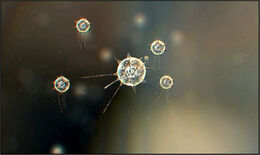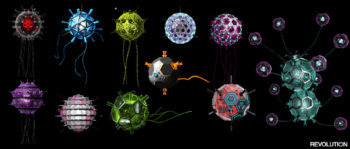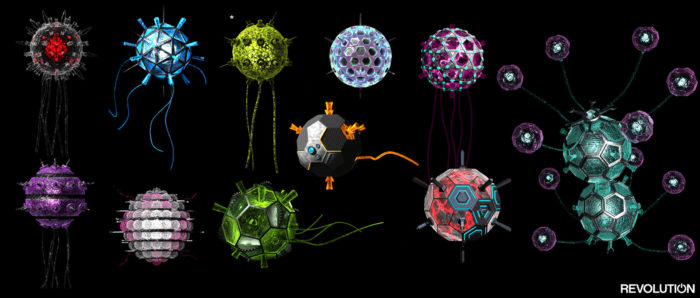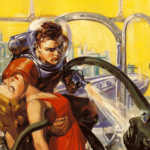Free Original Storyworld Ideas, Part 6: Nanites in Space Weapons and Aliens
This post is mostly science-fiction related, but if you bear with me, I’ll make a fantasy application.
What’s a nanite, anyway?
According to Wikipedia (http://en.wikipedia.org/wiki/Nanite), the word “nanite” is just one of several words used to describe very small machines. Research is underway to create such machines, continually making operating devices smaller and smaller.
Of course, as of now, nanites right now are nowhere near as small as they can be in theory. In theory and in the realm of science fiction, a fully-functioning machine could be so small as to be tinier than the smallest bacterium. And these tiny machines could be designed to reproduce themselves automatically, which over time would allow enough of them to form to accomplish almost any purpose.

Nanites envisioned.
From: https://revolution.fandom.com/wiki/Nanites
Spacefaring nanites
A machine that small would be an ideal candidate for interstellar space travel from a realistic or “hard science fiction” perspective. Why?
Because the most straightforward approach to travel to other stars is to simply go through space as fast as possible, the closer to the speed of light, the better. Light in a vacuum moves at around 186,000 miles per second, roughly 6 trillion miles a year. Even so the closest star system is over four years away at such a speed. So any velocity significantly short of light speed involves waiting a long time to get anywhere.
To science fiction fans, there’s nothing new in what I just said. But by means of numerous stories featuring starships routinely cruising up to light speed or going into hyperdrive/warp drive or warp gates/wormholes, fans may have been lulled into thinking that getting a spaceship up to the speed of light is relatively easy, given the right energy source. It actually isn’t. (Nor are warp drives or wormholes easy–both require a type of matter that has never been shown to exist, something with negative mass, which would be very strange and probably isn’t real.)
A realistic design to get a spacecraft up to 92% the speed of light, the theoretical Project Valkyrie (http://en.wikipedia.org/wiki/Project_Valkyrie), would involve a craft weighing only 100 tons, far smaller than the starship Enterprise. Even so, the estimated amount of antimatter required to get this craft up to speed, just one time, is another 100 tons! So half the weight of the craft would be antimatter fuel…and antimatter happens to be the single most expensive substance humans can manufacture (http://en.wikipedia.org/wiki/Antimatter#Cost). Making 100 tons of it is completely beyond even the most outlandish of human plans (science fiction writers get to skip this messy detail and simply assume we’ve already got a pile of antimatter somehow).
On the other hand, a nanite, being so small, is much easier to get up to light speed. In fact we’ve got particle accelerators right now that move ions of heavy elements like gold up to speeds approaching that of light (http://en.wikipedia.org/wiki/Relativistic_Heavy_Ion_Collider).
Nanite space explorers
So we can imagine perhaps in the not-too distant future, someone could assemble a particle accelerator designed to hurl nanites out to the unknown reaches of interstellar space fast enough to arrive at other stars in a matter of years instead of centuries. Once there, the nanites in theory could use magnetic fields to slow down and land somewhere around another star. There they could reproduce from elements they find wherever they land and eventually assemble themselves into a larger machine, one that could perhaps beam back pictures to us of the new worlds they’re exploring.
Even if a futuristic civilization had warp drive or hyperdrive or star gates or whatever, putting a particle accelerator out in space and shooting forth tiny machines at near-light speed would be much cheaper in terms of energy costs in relation to a realistic Starship Enterprise that it would seem every advanced civilization would use nanites or very small probes in this way. At least with stars nearby them, sending out hordes of tiny machines in all directions seems a really good idea. It would be an excellent way to explore the stellar neighborhood.
Nanite space weapons
Here’s a problem with my thought of exploration–isn’t it true, historically speaking, that harnessing forces to destroy is easier than wending the forces of nature to build? It’s easier use fuel and air to make a bomb than it is to make a jet engine; it’s easier to split the atom to destroy Hiroshima than it is to build an atomic power plant.
If we could accelerate nanites to other worlds to build probes, it would be even easier to send them on a mission to destroy, to consume all life they encounter, to seek out compounds from living bodies to reproduce swarms of new nanites. This idea has the potential to change a lot of science fiction. Having trouble with the Klingons? Simply fire some flesh-eating nanites at their home world…
Independence Day, the movie that features massive alien spaceships cruising through our atmosphere and blasting us with energy beams, would have it all wrong. The aliens would instead land on the planet with tiny particles too small for us to detect. These nano invaders would reproduce and reproduce, eating life on a small scale at first. Before they were even visible to the naked eye there would be billions of them, able to continue killing if even one of them survived any attempt to destroy them with radiation or chemicals. Our military would be useless, our medicines inadequate. Before long, all of mankind would be enveloped in a continually self-replicating tide of tiny devouring machines…
Note that even if you don’t want to see the future like this, even if you prefer starships in classic fleet battles in deep space instead, nanite weapons would still make a lot of sense as a supplement to starships. Starships could shoot nanites at one another and thus would have to incorporate anti-nanite defenses. Or even fire microprobes from an accelerator when it came time to explore unknown areas unsafe for the ship. Or there could be a “mine field” of nanites, floating freely in space, looking like ordinary dust particles, until they affixed themselves to the hull of the ship (as I mentioned in a previous post on Speculative Faith about space weapons)…or nanites could even provide stealthy means of communication or conveying information. Or as spying devices!
Nanite anti-nanite defense
Imagine that nanites become such a part of future warfare that it becomes standard to get a nanite “vaccination” of helpful nanites, whose job is to repel any hostile nanites who might invade your body. Such nanites could have many other benefits. They could enhance healing and clear out harmful plaques in the arteries and brain. They could perhaps undo aging, at least in part. They could assist your assimilation into the Borg Collective (OH WAIT THAT’S NOT A BENEFIT 🙂 )
Anyway, my idea of what’s funny aside, it could be that for many reasons, having nanites throughout your body is an ordinary thing in some highly advanced futuristic society. Maybe they’d even eliminate bacteria and viruses, making people free of communicable diseases. Though that might cause another problem.
Nanite-infested aliens
Inspired by the history of Europeans coming to the New World carrying bacteria to which the native inhabitants had little to no immunity, I thought: “What if aliens visiting Earth carried their own sort of infection or infestation, to which we humans had no immunity?” Sort of a War of the Worlds scenario in reverse…
That sort of thing has already been done, aliens carrying virulent disease(s) humans don’t carry. But what if the infestation were of nanites–what if nanites become a standard part of healthcare for any advanced technological species, for reasons I’ve already suggested? (Just as mask-wearing and hand washing and social distancing have recently become important to modern life.)
To the degree that nanites are literally crawling all over (and inside) the bodies of high-tech aliens–or perhaps time travelers from Earth’s distant future. What if these nanites potentially posed a risk to the human race?
It could be of course that nanites would be programmed in such a way as not to harm us, but what if the standard way nanites were kept from invading another creature’s body would be by your own nanites?
When hypothetical aliens of this type contact one another, the nanites on a particular alien’s body intended to be there would always outnumber those that would accidentally cross over from contact with someone else. The ones designed to be on a particular body could have a swarm and hive mentality–effectively collaborating to defend the host and keep any outside nanites from making any trouble.
But for us human beings, our immune systems are not designed to fight machines. We would have no immunity at all. Casual contact–a handshake, such as in the Star Trek movie “First Contact,” would at first seem to have no ill effect at all. But eventually, perhaps in a few days, Dr. Cochrane would find the skin on his hand begins to sluff off…and his arm begins to swell…in a week, the pain is unbearable and is all over his body. In ten days, he is dead…but everyone he touched and everyone who touched him in the meantime is infested by tiny robots that reproduce wherever they are and which attack whatever does not mach their original host. Leaving everyone totally defenseless…
Nice guy alien nanites versus alien invaders
Actually, nice guy aliens who meet us on purpose would either find a way to shut down their own nanites or would refrain from touching us if they were nanite-infested. But what about alien invaders? Will Smith in Independence Day punches an alien in the face…what if he found that within hours his knuckles began to blister…and per the original story, the virtually impossible uploading-of-a-virus-on-a-completely-unknown-computer-system still works, the shields go down, the aliens get blown up. But pilots first, in droves, then every person they know, then probably the entire human race, find themselves dissolved bit by bit by tiny little machines that don’t scrub out or bleach out well enough, that radiation can’t entirely eliminate, and which aren’t even intended to be a weapon. War of the Worlds, in reverse.
Accidental nanite infestation
The most interesting for this kind of story might be an accidental encounter. Say a crash landing on our planet. Or an alien space vessel sends a mayday and nearby humans (who’ve never encountered aliens before) fly a spaceship or starship over to help. Neither the humans nor the aliens would know what the disastrous results to humanity will be. The humans because they don’t know the aliens carry nanites–and the aliens because they don’t realize we humans don’t…
But our heroes, of course, will figure out way to shut down the nanites. Perhaps with help from the future–or from “nice guy” aliens.
Nanites for fantasy fans
So what’s all this to a fan of fantasy? You aren’t interested in starships and eating metal and all that crap. For you, if it isn’t magical, it’s no fun–okay, first off you and I are clearly different, right? But anyway, I do have something for you.
Let’s say a fantasy world is inhabited by tiny creatures. Say microscopic pixies. Imagine a fantasy world in which the microscopic pixies are tamed (through the proper use of magic, of course) and are swarming over a wizard’s body like nanites over aliens. Or are used as weapons, mines, spies, and are sent out in vast numbers. Etc. The same ideas as written here, or similar, but with a fantasy twist (such as the nanite/pixies have a will of their own…)
Conclusion

Nanite types: Copyright Linden Stirk
There are of course plenty of science fiction stories that feature nanites, most famously probably Star Trek has them as part of what makes the Borg Collective who they are. But really in the Star Trek universe everyone should have and use nanites, Federation, Klingons, Romulans, etc. They’re such a relatively inexpensive solution to many problems.
They’re cheaper to launch into space than full-sized explorers, making them better offensive weapons and explorers. They could also be part of stationary defenses, spy gear, commo gear, and healthcare. They could become so standard that futuristic humans or aliens would be unable to imagine a species without them–which could prove disastrous for the human race. Or other species.
So what are your thoughts on this topic? Do you have favorite stories featuring nanites? Is any one aspect of the way nanites could be used more interesting to you than the rest–if so, what would that be? Any other comments?
https://travissbigidea.podbean.com/e/free-original-storworld-ideas-part-6-nanites-in-space-weapons-and-aliens/ )












































No fair skimping on the fantasy nanites! My Impworld/Otherworld Saga largely plays on this. In that series, gamers are playing the universe’s most popular fantasy adventure game on a terraformed alien world . Improbable beasts such as dragons and manticores are actually biological robots . And nanites provide much of the special effects & mechanics of the game’s magic . Players receive medical treatment from nanites in order to accelerate their healing as per a healing potion. Nanites also form into cameras to film the spectacle when needed. Basically, beneficial nanites are infused into the future and are employed to accommodate this fantasy LARP. My nanites are also used in bodysuits that some players use to play characters like ogres and centaurs but these are rare in the game because nanites use up a lot of resources. We replace our cells on a regular basis; I reason that nanites have the same basic requirements. A nodal interface into the brain (already ubiquitous due to the prevalence of immersive VR in the world) is required to complete the jump between, say, human and troll. Players are levitated to the proper height where nanites give the holographic illusion of their game form and provide situational physicality or substance when required (viz., grabbing a torch, landing a punch, etc.).
In the non-game world, weaponized nanites take three forms. Guns with magazines that generate ammunition out of inanimate materials the mag comes into contact with when the mag is taken out of the gun and activated. Drones made from nanite swarms. And the dreaded gray goo that eats everything and has to get shut down with an EMP or a nuke if you really want to be sure.
Well, I have issued the complaint that Christian writers of speculative fiction in general could be more original and creative in their world building–clearly that gripe on my part doesn’t apply to you!
Though, actually, sir, if you write a fantasy setting in which everything works for science fiction reasons, you’re at most writing a multigenre story, though someone could argue your tale is actually straight-out science fiction. Like the Dream Park novel by Larry Niven and Steve Barnes.
As for replacement needs, recall that not even all life forms break down at the same rate, so while nanites surely would break down, I assume they could be made much more durable than, say, human biological cells.
Also, a good gray goo should include at least some non-metallic nanites. Ones immune to an EMP… Though of course a nuke works on anything due to heat and high radiation…but you gotta be sure you have them all destroyed… (And why wouldn’t you? Why wouldn’t at least a portion of the gray goo disperse as widely as possible…?)
It is true that the nanites are more resilient than human cells but they’re also being intentionally subjected to higher stress and resource requirements since they’re being used on a constant basis in the game. The action in my books rarely eases up but this is partly because part of the premise is that the Gamelords desire ratings for their live casts and thus they create near constant peril to keep everyone watching.
As for the gray goo… I may have to think about that. Many of my robots are biological. I favor metal for military applications simply because metal allows for structural strength and better defense but I might need to flesh out (pun intended) how a purely biological military gray goo might be neutralized.
Technically my books are considered gamelit like Ready Player One but it is very much scifi meets fantasy. It’s been a lot of fun to write!
Sounds like it!
There was one movie that I don’t remember the name of, but it was about this atheist guy that was working on this AI and nanite project. He nearly died and to save him his SO uploaded his brain to a computer. He basically starts to play God, amassing power and trying to lure everyone in with healing and stuff. He uses nanities to cure people’s ailments, but considering how much control he was starting to have over everything his SO had to find a way to stop him.
I do think it would be good if more fantasy and sci fi started addressing these issues, the fact that we’re increasingly getting more tech that will be nearly impossible to detect and deal with on our own. People say to check for hidden cameras in an AirBnB room rental, but eventually cameras will be so tiny that they can’t be detected so easily. And if nanites are developed enough, they’ll become so common that a lot of people would be able to use them to whatever end they want, for better or for worse. Some of them may even think they’re doing good with them when they’re not. And there’s a lot of interesting yet dangerous topics that come up whenever we talk about implanting advanced tech in a human body. Presumably, a lot of advanced parts might end up being connected to the internet and other outside sources in some way. Maybe to receive software updates or to look up ways to solve certain problems. Or, at the very least, so the device can get repaired. But that means those parts can get hacked just like a regular computer can. Nanites would be the same, only it may be more difficult to purge them if there’s a problem. (Though maybe it’d actually be easier, assuming they were built a certain way)
Nanites would be useful, and there’s tons of applications where I wouldn’t have a problem with them, but I do cringe when I think of all the possibilities that might actually come up.
In one of my sci fi stories I did consider having a certain entity be composed of nanites. I decided to have it be composed of something else, but some aspects of its behavior probably seems nanite like.
Yeah, thank you for bringing up issues of surveillance and nanites coming under hosticle control. I briefly mention their potential for spying and my reference to the Borg is meant to be a reference to the control issue. But I only touched on those issues and both of them are definitely important!
Sounds vaguely like a Ghost in the Shell: Stand Alone Complex plot. Probably better than the current SAC’s plot.
I haven’t seen Ghost In The Shell, but I did figure out what movie I was talking about. It’s called Transcendence: